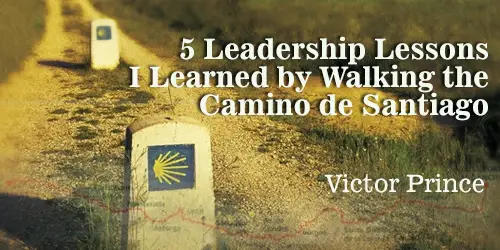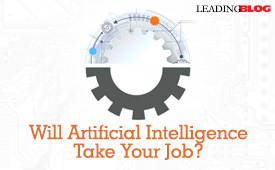 Leading Blog | Posts by Month |
 Leading Blog | Posts by Month |
07.31.17

LeadershipNow 140: July 2017 Compilation
See more on
Posted by Michael McKinney at 08:17 AM
07.14.17

5 Leadership Lessons I Learned by Walking the Camino de Santiago
T 1. Welcome Help When you walk for a month, you inevitably get lost. In one little village, three older gentlemen sitting in a shady spot outside the little café jumped and pointed me in the right direction when I took a wrong turn. I realized that they were sitting there specifically to help direct lost hikers. It was their pastime. That experience taught me that welcoming help from others was not just about the specific piece of help I received when I asked. It also made the person helping me feel good and be invested in my success. Ever since the Camino, I have vowed to be more welcoming of help from others, at work and beyond. 2. Learn from the Past When I decided to walk the Camino, I eagerly jumped into the planning. I plotted out a 29 day itinerary that optimized my distances per day and found a bed I could reserve each night. That exercise took days, tapped my analytical skills, and resulted in a large spreadsheet that I was proud to show off. That is until I realized that I had recreated the same itinerary that several guidebooks had already figured out. People have been walking the Camino for over 1000 years. Instead of taking a step back to see what I could have learned from others who went before me, I plunged right into the task. Since the Camino, I am more thoughtful when I start a new project to look for lessons from the past. 3. Think About the Future Any trail that has remained popular for over 1000 years can teach us how to build longevity in our organization. One thing behind the Camino’s longevity is the ethos of the hikers who walk it to leave it better than they found it. Hikers generally don’t litter on the trail and pitch in where they can to keep the churches, hostels and facilities along the trail in good shape for hikers to follow. That same ethos is important for leaders. Leaders need to think about their successors as they make decisions in their jobs. Their goal should be to leave their role and team in a better position than they inherited it. 4. Don’t Judge Others People from many different backgrounds from all over the world hike the Camino. Everyone dresses in much the same way while walking, giving few clues from their outward appearance about their background. Hikers learn to reserve judgment about others. Instead of silently critiquing others, hikers support each other as they go through the same difficult challenge of walking across a country. They may not know how or why another person got on the trail, but they know the shared challenges they are facing and simply focus on those. 5. Stretch Yourself Walking across a country sounded like a crazy thing to do before I did it. By doing it, I gained self-confidence to do other bold things. Walking the Camino emboldened me to check off a goal that I had long thought was beyond my abilities – writing a book. While I was walking the Camino, I thought a lot about my career and the leadership lessons I had learned. I decided to write a book about those insights. That book, Lead Inside the Box: How Smart Leaders Guide their Teams to Exceptional Results (Career Press), was named a Top 20 Leadership Book of 2016. This week, my third book, The Camino Way: Lessons in Leadership from a Walk Across Spain (AMACOM) comes out. I recommend hiking the Camino to anyone who can. The combination of the physical challenge, the alone time for introspection, and the opportunity to meet people from around the world is a wonderful means of self-improvement. If you can’t walk the Camino, search for other experiences that provide those three elements.  
Posted by Michael McKinney at 07:53 AM
07.10.17

The Mathematical Corporation
Y A mathematical corporation is one that takes advantage of machine intelligence by collaborating with it to achieve leading-edge results. It will require a shift in your thinking. “As a leader,” say Josh Sullivan and Angela Zutavern in The Mathematical Corporation, “you need to evolve your focus to excelling through imagination, creativity, reasoning, and problem structuring.” Leading in the era of the mathematical corporation means learning to work with the machine to investigate mountains of data not by braking them down, but by keeping them together to mine insights never before imaginable. It means being able to distinguish what machines are good at doing from what people are good at doing. When people and machines are appropriately paired we can explore heretofore impossible strategies and execute incredible solutions. Machines will not replace people but we will need to develop and capitalize on some uniquely human skills. “People will continue to be better than machines at many of the loftiest cognitive tasks, like asking questions to clarify a problem, composing experiments to test hypotheses, and drawing on truths in one discipline to elicit insights in another.” Because of the machine’s ability to synthesize vast amounts of data, it would be wise to question your own judgments when machines offer a different conclusion from your own. Machines, for example, can recognize patterns better than we can. That said, “computers don’t know the cause of a pattern. They don’t have the human appetite to get to the bottom of the matter, and they don’t ask, ‘Just how does cause A lead to effect B?’ They learn, infer, and have high recall accuracy, but they don’t know the story of cause and effect. So, the task of taking a cause-and-effect understanding of a business system and crafting a strategy from it remains a people job.” Getting the Questions Right While Big Data adds complexity, it is only a problem if you don’t know how to mine it for value. The key skill for leaders is to be able to ask better questions than to offer solutions. Asking the right questions is critical. Poor questions lead to questionable insights. “That’s why as a leader, you need to remain at the tip of the process, seeing the world in a much broader and more differentiated way than others.” Not only asking the right questions but removing our own biases from them, will bring us breakthrough insights and more nuanced answers. Another issue we will have to work through is not projecting our limitations and constraints on the machine. Although we have a mental model that we filter the world though, we must be careful not to constrain the machine—our questions—in the same way. What About Intuition? In the mathematical corporation, the role intuition will shift from judging reality to judging models. “No matter your feeling on intuition, its role is destined to shift to a smaller, if still critical position. As machine intelligence converts implicit understanding to exploit facts, replaces implicit assumptions with data-givens, counters biases with hard evidence, we have to admit the superiority of the cold facts encoded in 1s and 0s.” Often it will require a leap of faith on our part. We will need to learn to ask bigger questions and questions that will lead us to better questions. The best machine collaborators will see this as a learning journey. “Conventional strategic planning practice calls for a relentless search for answers during a detailed analysis of context and a relentless analysis of the opportunity to find the right answer in one go. But when the answer is over the horizon, no amount of analysis of the landscape up front will reveal it. You need to go on a learning journey—sailing to the far shores to find the best answer.” It requires a commitment to a cycle of questioning and learning, questioning and learning. As digital technologies continue to develop and improve, leaders will need to become wise and discerning leaders of machines. Leaders will not only be expected to use this technology to their advantage to solve their own organizational issue but to help answers the questions that exist beyond their own walls.   
Posted by Michael McKinney at 05:24 PM
07.05.17

The Bridge to Growth
W In today’s business climate, the cadence between strategy and execution is compressing, making the integration of the two more important than ever. Too many workers are being left out of this equation. More and more people are disconnected from their company’s goals, even though they still report being satisfied with their jobs. A Global Workforce Survey conducted by Towers Watson revealed that a mere 21 percent of workers feel engaged and truly committed to their company’s success and goals, even though 86 percent report liking their jobs. Is this reflective of a failure of leadership, a shift in the attitudes of today’s workers, or both? Apparently, many people are settling for a job that satisfies their basic needs, yet denies them a motivating answer to two important questions: “How does my personal work connect to my company’s goals, and how can I help us achieve them?” In these cases, leaders have unfortunately failed to fully engage workers in either the development or execution of their company’s mission, goals, and ultimately its journey toward success or failure. Too often, workers are being over-managed and under-led. I believe this “commitment gap” represents the largest source of untapped potential to create economic value in our society today. How can leaders tap into this gap and raise the performance bar? This question matters more now than it ever has. As our world becomes more socially connected, more women progress into leadership roles, and millennials seek more meaning and purpose in their work than previous generations did, the principles of servant leadership are becoming more relevant than ever before. Based on my experience leading high performing teams over the last 36 years, I developed a blueprint of nine proven leadership principles I've used to improve the performance of several businesses by moving workforces from satisfactorily disengaged to enthusiastically committed to winning: 1. Grow leaders and difference-makers, not just followers. 2. Build and orchestrate synergistic, high-performance teams more powerful than the sum of their parts. 3. Focus your organization on strategic priorities and simplify operations to accelerate progress. 4. Champion the people who purchase and use your products and services. 5. Cultivate a performance-based culture of innovation that unleashes the innate desire in the people you lead to solve, create, and contribute to winning. 6. Communicate relentlessly to give your workforce the context they need to sign up for and truly commit to achieving company goals. 7. See the world through the eyes of others, and your example will breed a healthier organization. 8. Be the model you want emulated. Operate transparently, deliver on your promises, and remain steadfastly focused on doing the right things. 9. Coach people to achieve more than they thought possible. They need a model of success more than they need a critic. Inspire your entire organization to step up by revealing what success looks like, catching people doing something well, and showing your gratitude publicly. If you connect with these principles, I encourage you to check out my new book The Bridge to Growth. It's packed with useful tips and tools, and each leadership principle is articulated using real-world success models that bring the principles to life.  
Posted by Michael McKinney at 12:03 AM
07.04.17

America Through the Eyes of the Founding Fathers
I But laws he believed, could not prevent this hypocrisy. No law, no constitution could save an immoral people. While the Founding Fathers believed in the necessary separation of Church and State, they believed no discussion of morals was possible without an agreed-upon philosophy – a philosophy that superseded the logic of men. So Adams concluded that “Our Constitution was made only for a moral and religious people.” George Washington also said as much halfway through his Farewell Address of 1796. He stated: “Of all the dispositions and habits which lead to political prosperity, Religion and morality are indispensable supports.” He added, “And let us with caution indulge the supposition that morality can be maintained without religion. Whatever may be conceded to the influence of refined education on minds of peculiar structure, reason and experience both forbid us to expect that National morality can prevail in exclusion of religious principle.” Both Adams and Washington are appealing to a morality that was eternal—beyond the customs of man. A morality that didn’t shift on convention. John Adams wrote to the Massachusetts Militia: While our country remains untainted with the principles and manners which are now producing desolation in so many parts of the world; while she continues sincere, and incapable of insidious and impious policy, we shall have the strongest reason to rejoice in the local destination assigned us by Providence. James Madison, the fourth President of the United States, believed that the governed were obliged to control itself. Furthermore, it was the responsibility of a virtuous people to select leaders that would reflect that ideal. Leaders that would be capable by virtue of their own character, to adapt these eternal morals that Adams often spoke of, to particular circumstances. Madison wrote: But I go on this great republican principle, that the people will have virtue and intelligence to select men of virtue and wisdom. Is there no virtue among us? If there be not, we are in a wretched situation. No theoretical checks--no form of government can render us secure. To suppose that any form of government will secure liberty or happiness without any virtue in the people, is a chimerical idea. If there be sufficient virtue and intelligence in the community, it will be exercised in the selection of these men. So that we do not depend on their virtue, or put confidence in our rulers, but in the people who are to choose them.
Posted by Michael McKinney at 12:47 AM
07.01.17

First Look: Leadership Books for July 2017Here's a look at some of the best leadership books to be released in July.    
For bulk orders call 1-800-423-8273  Build your leadership library with these specials on over 39 titles. All titles are at least 40% off the list price and are available only in limited quantities. "A room without books is like a body without a soul.” — Marcus Tullius Cicero
Posted by Michael McKinney at 03:15 PM
|
BUILD YOUR KNOWLEDGE


How to Do Your Start-Up Right STRAIGHT TALK FOR START-UPS 
Grow Your Leadership Skills NEW AND UPCOMING LEADERSHIP BOOKS 
Leadership Minute BITE-SIZE CONCEPTS YOU CAN CHEW ON 
Classic Leadership Books BOOKS TO READ BEFORE YOU LEAD |
|